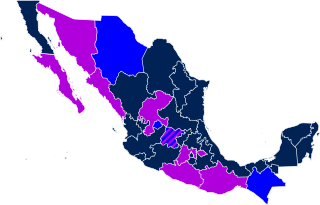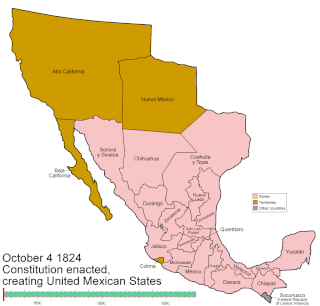
This is a list of Mexican states by date of statehood, that is, the date when each state was accepted by Congress of the Union as a free and sovereign state of the United Mexican States.

This is a list of Mexican states by date of statehood, that is, the date when each state was accepted by Congress of the Union as a free and sovereign state of the United Mexican States.
The effective independence of Mexico reached on September 27, 1821, does not meant the independence of the states, because Mexico was the only Latin American country which became independent from Spain as a monarchy. After the fall of the Mexican Empire, the Federal Republic was established on July 12, 1823. [1]
Although 18 of the 19 founder states can be considered official members of the federation since the enactment of the Constitutive Act of the Mexican Federation on January 31, 1824; eleven of them were ratified as states before the enactment and some of the others were included as three states (the internal States of North, Western and Eastern). 6 7 Tamaulipas, Tabasco and Chiapas were ratified after the enactment of the act. 8
All the later admission dates were set by law or decree of congress, except for Chiapas, whose admission was determined by its own people in a referendum. [2]
This list does not account the secession of several states during the establishment of the Centralist Republic and the territorial changes made during the civil and foreign wars.
| # | State | Admission 1 | Preceding Entity 2 [3] | |
|---|---|---|---|---|
| 1 | | México | December 20, 1823 [4] | Intendancy of México, then Province of México |
| 2 | | Guanajuato | December 20, 1823 [4] | Intendancy of Guanajuato, then Province of Guanajuato |
| 3 | | Oaxaca | December 21, 1823 [4] | Intendancy of Oaxaca, then Province of Oaxaca |
| 4 | | Puebla | December 21, 1823 [4] | Intendancy of Puebla, then Province of Puebla de los Angeles |
| 5 | | Michoacán | December 22, 1823 [4] | Intendancy of Valladolid, then Province of Valladolid |
| 6 | | San Luis Potosí | December 22, 1823 [4] | Intendancy of San Luis Potosí, then San Luis Potosí |
| 7 | | Veracruz | December 22, 1823 [4] | Intendancy of Veracruz, then Province of Veracruz |
| 8 | | Yucatán 3 | December 23, 1823 [4] | Captaincy General of Yucatán, Intendancy of Yucatán, Province of Mérida de Yucatán and then Republic of Yucatán |
| 9 | | Jalisco | December 23, 1823 [4] | Nueva Galicia, Intendancy of Guadalajara, Province of Guadalajara |
| 10 | | Zacatecas | December 23, 1823 [4] | Nueva Galicia, Intendancy of los Zacatecas, Province of Zacatecas |
| 11 | | Querétaro | December 23, 1823 [4] | Intendancy of México, then Province of Querétaro |
| 12 | | Sonora 4 | January 10, 1824 [4] | Nueva Navarra, Province of Sonora |
| 13 | | Tabasco | February 7, 1824 [5] | Split off from Veracruz and Yucatán |
| 14 | | Tamaulipas | February 7, 1824 [4] | Nuevo Santander, then Province of Santander |
| 15 | | Nuevo León | May 7, 1824 [6] | New Kingdom of León, then Province of New Kingdom of León |
| 16 | | Coahuila 5 | May 7, 1824 [7] | Nueva Extremadura, then Province of Coahuila |
| 17 | | Durango | May 22, 1824 [8] | Nueva Vizcaya, then Province of Nueva Vizcaya |
| 18 | | Chihuahua | July 6, 1824 [9] | Nueva Vizcaya, then Province of Nueva Vizcaya |
| 19 | | Chiapas | September 14, 1824 [2] | Captaincy General of Guatemala, then Province of Guatemala |
| 20 | | Sinaloa | October 14, 1830 [10] | Split off from Estado de Occidente |
| 21 | | Guerrero | October 27, 1849 [11] | Formed from parts of México, Puebla and Michoacán |
| 22 | | Tlaxcala | December 9, 1856 [12] | Territory of Tlaxcala |
| 23 | | Colima | December 9, 1856 [13] | Territory of Colima |
| 24 | | Aguascalientes | February 5, 1857 [14] | Territory of Aguascalientes |
| 25 | | Campeche | April 29, 1863 [15] | Territory of Campeche, split off from Yucatán |
| 26 | | Hidalgo | January 16, 1869 [16] | Split off from México |
| 27 | | Morelos | April 17, 1869 [17] | Split off from México |
| 28 | | Nayarit | January 26, 1917 [18] | Territory of Tepic |
| 29 | | Baja California | January 16, 1952 [19] | North Territory of Baja California |
| 30 | | Quintana Roo | October 8, 1974 [20] | Territory of Quintana Roo, split off from Yucatán |
| 31 | | Baja California Sur | October 8, 1974 [21] | South Territory of Baja California |

The United Mexican States is a federal republic composed of 32 federal entities: 31 states and Mexico City, an autonomous entity. According to the Constitution of 1917, the states of the federation are free and sovereign in all matters concerning their internal affairs. Each state has its own congress and constitution.

Lesbian, gay, bisexual, transgender, and queer (LGBTQ) rights in Mexico expanded in the 21st century, keeping with worldwide legal trends. The intellectual influence of the French Revolution and the brief French occupation of Mexico (1862–67) resulted in the adoption of the Napoleonic Code, which decriminalized same-sex sexual acts in 1871. Laws against public immorality or indecency, however, have been used to prosecute persons who engage in them.
Events in the year 1848 in Mexico.

Same-sex marriage is legally recognized and performed throughout Mexico since 2022. On 10 August 2010 the Supreme Court of Justice of the Nation ruled that same-sex marriages performed anywhere within Mexico must be recognized by the 31 states without exception, and fundamental spousal rights except for adoption have also applied to same-sex couples across the country. Mexico was the fifth country in North America and the 33rd worldwide to allow same-sex couples to marry nationwide.

Mexico has experienced many changes in territorial organization during its history as an independent state. The territorial boundaries of Mexico were affected by presidential and imperial decrees. One such decree was the Law of Bases for the Convocation of the Constituent Congress to the Constitutive Act of the Mexican Federation, which determined the national land area as the result of integration of the jurisdictions that corresponded to New Spain, the Captaincy General of Yucatán, the Captaincy General of Guatemala and the autonomous Kingdoms of East and West. The decree resulted in the independence from Spain.

Mexico uses four time zones:

Events in the year 1835 in Mexico.
Events in the year 1839 in Mexico.
Nuestra Belleza México 2009, the 16th annual Nuestra Belleza México beauty pageant, was held at the Centro de Convenciones Yucatán Siglo XXI of Mérida, Yucatán, Mexico on September 20, 2009. It was the second time there were back-to-back victories for a state in Nuestra Belleza México history: Ximena Navarrete from Jalisco was crowned by outgoing Nuestra Belleza México titleholder Karla Carrillo also from Jalisco. She was the third Jalisciense to win this title. Thirty-four contestants of the Mexican Republic competed for the national title. Navarrete competed in Miss Universe 2010 in the US and won the Universal Title.

Nuestra Belleza México 2010, the 17th annual Nuestra Belleza México beauty pageant, was held at the Auditorio Parque Las Maravillas in Saltillo, Coahuila, Mexico on September 25, 2010. The State of Jalisco, won for the third consecutive year with Karin Ontiveros, who later competed in Miss Universe 2011 in Brazil. Ontiveros was crowned by outgoing Nuestra Belleza México titleholder and Miss Universe 2010 Ximena Navarrete. She was the fourth Jalisciense to win this Title. Thirty-one contestants of the Mexican Republic competed for the national title.
Most Mexican states do not have an official flag. For these states, a de facto flag is used for civil and state purposes. State flags of Mexico have a 4:7 ratio and typically consist of a white background charged with the state's coat of arms.

Televisa Regional is a unit of Grupo Televisa which owns and operates television stations across Mexico. The stations rebroadcast programming from its subsidiary TelevisaUnivision's other networks, and they engage in the local production of newscasts and other programs. Televisa Regional stations all have their own distinct branding, except for those that are Nu9ve affiliates and brand as "Nu9ve <city/state name>".
Nuestra Belleza México 2012, the 19th annual Nuestra Belleza México beauty pageant, was held at the Poliforum del Centro de Convenciones in Tuxtla Gutiérrez, Chiapas, Mexico on September 1, 2012. Thirty-five contestants from Mexico competed for the national title, which was won by Cynthia Duque from Nuevo León, who later competed in Miss Universe 2013 in Russia. Duque was crowned by outgoing Nuestra Belleza México titleholder Karina González. She is the fourth Neoleonesa to win this title.
Events in the year 1863 in Mexico.
Events in the year 1891 in Mexico.
Events in the year 1857 in Mexico
The following television stations broadcast on digital or analog channel 31 in Mexico:
The electoral regions of Mexico are geographic areas composed of various states used for the election of the 200 proportional representation legislators to the Chamber of Deputies.